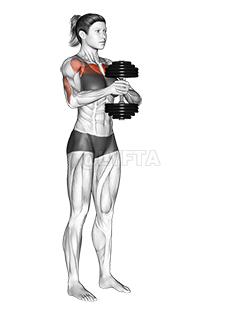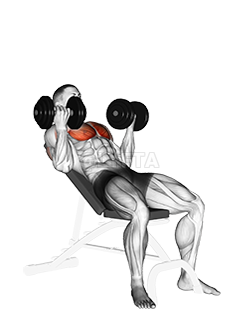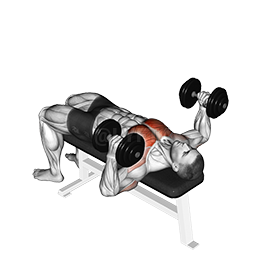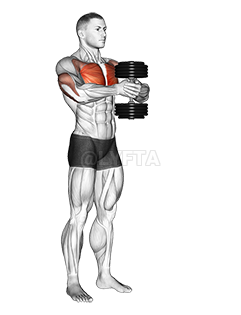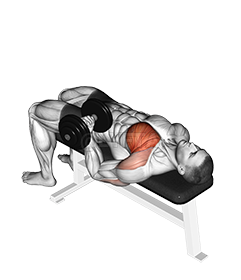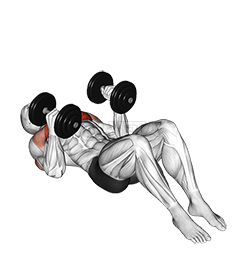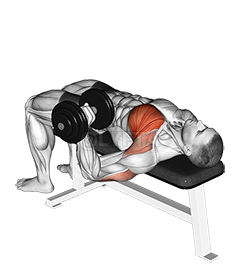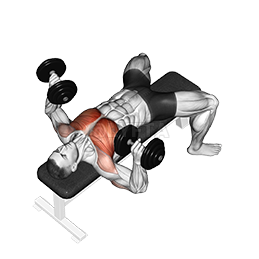
Dumbbell Lying One Arm Press
Exercise Profile
Related Exercises:
Introduction to the Dumbbell Lying One Arm Press
The Dumbbell Lying One Arm Press is a strength training exercise that primarily targets the chest muscles, but also works the shoulders and triceps. It's ideal for individuals at any fitness level, especially those wanting to improve upper body strength and muscle definition. Incorporating this exercise into your routine can enhance muscle balance and coordination, promote unilateral strength, and offer variety to your workout regimen.
Performing the: A Step-by-Step Tutorial Dumbbell Lying One Arm Press
- Extend your arm holding the dumbbell straight up towards the ceiling, keeping your wrist straight and your palm facing your feet.
- Slowly lower the dumbbell down to the side of your chest, keeping your elbow at a 90-degree angle and your forearm vertical to the floor.
- Push the dumbbell back up to the starting position, fully extending your arm but without locking your elbow.
- Repeat these steps for the desired number of repetitions, then switch to the other arm.
Tips for Performing Dumbbell Lying One Arm Press
- Controlled Movement: Avoid the common mistake of rushing through the exercise. It's crucial to maintain a slow and controlled movement throughout the press. Lower the dumbbell until your elbow is slightly below the bench level, then push it back up. This controlled motion will help engage your muscles effectively.
- Stability: Since you're using one arm, it's easy to lose balance. To avoid this, engage your core and make sure your other arm is either resting on your body or the bench for added stability. Do not let your body tilt to the side while lifting the dumbbell.
- Breathing:
Dumbbell Lying One Arm Press FAQs
Can beginners do the Dumbbell Lying One Arm Press?
Yes, beginners can do the Dumbbell Lying One Arm Press exercise. However, it's important to start with a weight that is comfortable and manageable to avoid injury. Proper form is also crucial, so beginners may want to have a trainer or experienced gym-goer assist them initially. As with any new exercise, it's recommended to start slowly and gradually increase weight and repetitions as strength and endurance improve.
What are common variations of the Dumbbell Lying One Arm Press?
- Incline Dumbbell One Arm Press: Performing the exercise on an incline bench targets the upper chest and shoulders more directly.
- Dumbbell One Arm Press on Stability Ball: This variation adds an element of balance, engaging the core muscles along with the chest and arms.
- Alternating Dumbbell One Arm Press: In this variation, you alternate pressing one dumbbell at a time, which can help improve muscular balance and coordination.
- Decline Dumbbell One Arm Press: This version, done on a decline bench, targets the lower pectoral muscles, providing a full range of motion.
What are good complementing exercises for the Dumbbell Lying One Arm Press?
- Tricep Dips: Tricep Dips complement the Dumbbell Lying One Arm Press by working the secondary muscles used in the press, namely the triceps and shoulders, thus enhancing overall upper body strength.
- Push-ups: Push-ups complement the Dumbbell Lying One Arm Press by using body weight to work the same muscle groups - the chest, shoulders, and triceps - in a different way, which can help prevent muscle adaptation and keep your workout challenging.
Related keywords for Dumbbell Lying One Arm Press
- One Arm Dumbbell Chest Press
- Single Arm Dumbbell Press
- Lying One Arm Dumbbell Workout
- Chest Exercise with Dumbbell
- One Arm Dumbbell Chest Exercise
- Dumbbell Workout for Chest
- Single Hand Dumbbell Chest Press
- Lying Single Arm Chest Press
- One Arm Dumbbell Press for Chest
- Chest Targeting Dumbbell Exercise.
